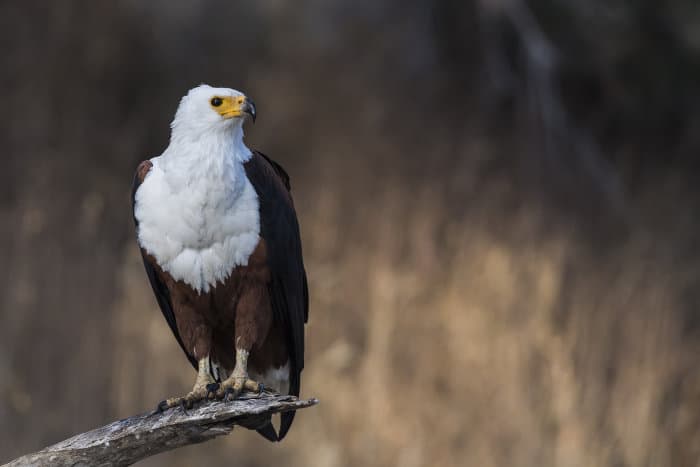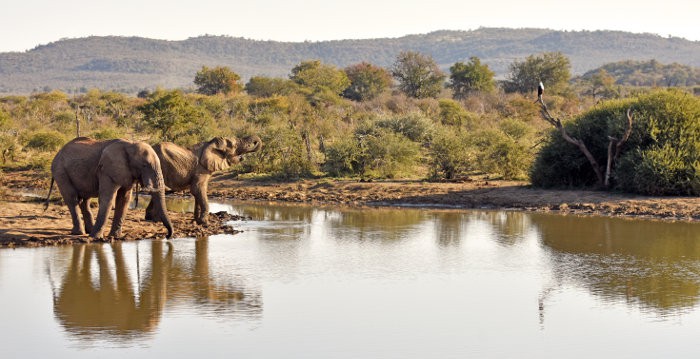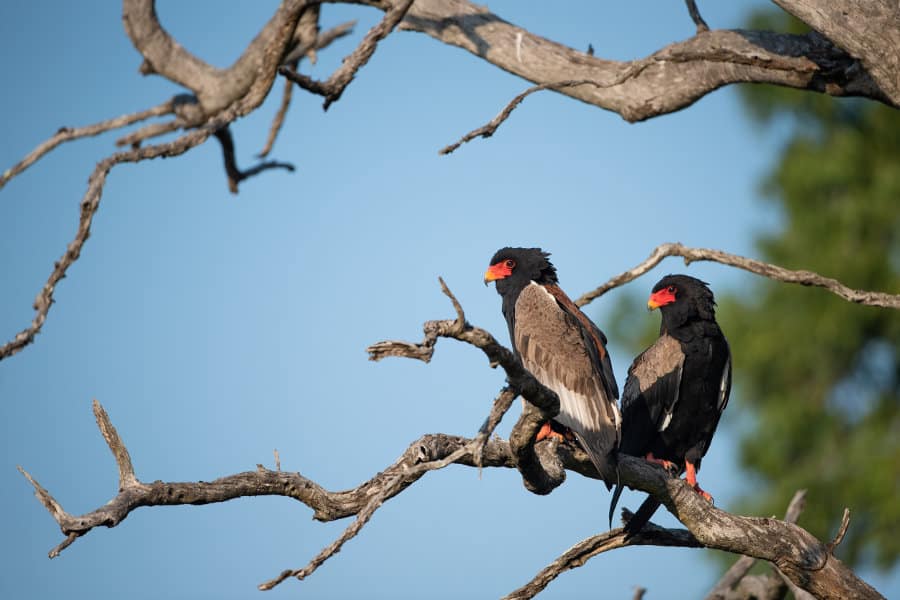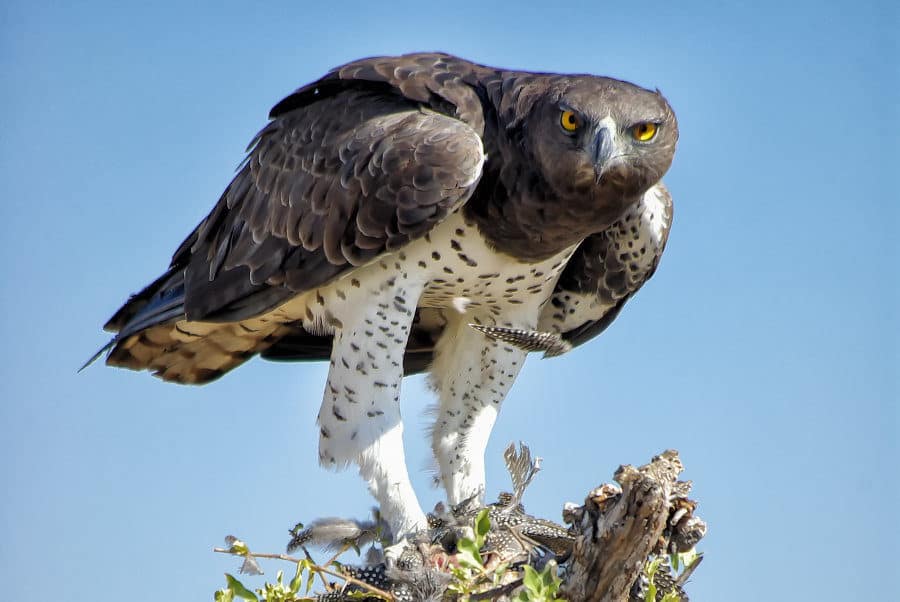Fish eagles are a symbol of Africa.
These beautiful raptors soar proudly across blue skies. Yodelling in high-pitched yelps they reflect a continent’s love for song. Their very image sums up the African wilderness, with rivers meandering across elephant and antelope dominate plains.
Here are 14 incredible facts about the African fish eagle, including the best places to see them in the wild.
1. There are seven species of fish eagle

The African fish eagle is just one of seven. The Madagascan fish eagle is the only other species native to Africa. Steller’s sea eagle is a rare bird found in north-eastern Asia while Sanford’s fish eagle is endemic to the Solomon Islands.
Three fish eagle species live on the Indian subcontinent, mostly around the Himalayan foothills. These are the grey-headed fish eagle, the lesser fish eagle, and the Pallas’s fish eagle.
2. The African fish eagle is the national bird of four countries

These four countries are where the bird is found in abundance: Namibia, Zimbabwe, Zambia and South Sudan. Not only is it their national bird, the fish eagle features on the coat of arms of all these countries.
Do you know a Zambian flag from a Zimbabwe flag? They are confusing because an African fish eagle appears on both of them.
3. There are around 300,000 fish eagles in Africa

This vast population is spread across most of East and Southern Africa. It makes them one of the most numerous predatory birds in Africa. The IUCN classifies African fish eagles as animals of least concern.
4. Fish eagles are one of the oldest of all living birds

They belong to the Haliaeetus genus of sea eagles, one of the most ancient bird genera. These birds have been here since long before man. In fact, they’ve been here since before primates!
5. They are kleptoparasites

This means they actively steal food from other birds. Goliath herons and saddle-billed storks are their common victims, but fish eagles can scavenge like the best of them and will take from almost any other bird.

You could call them the pirates of Africa’s rivers and lakes!
6. An incredible diverse dinner menu

African fish eagles aren’t just scavengers. Nor do they feed purely on fish.
Fish is supplemented by other birds and mammals. They are incredibly efficient hunters, picking on ducks, waterfowl, and various birds.
In East Africa they even feed on flamingos. Other prey includes lizards, frogs and carrion.
7. African fish eagles sometimes eat monkeys and crocodiles

These raptors are such strong hunters they sometimes target unusual prey. Who would think that a fish eagle can carry off a baby crocodile! Or a small monkey!
African fish eagles can carry prey that’s up to ten times its own body weight. Rather than carry it high into the sky it will drag prey across the water surface, until it reaches a safe place to land.
8. They mate for life

Fish eagles are loyal birds. They mate for life, with the actual mating taking place during the dry season when the waters are lowest.
Every season the loved-up couples return to nests they have used before. Nests are built upon and some reach over two metres across.
9. The fish eagle has many names

In Zimbabwe they are called hungwe, in the Shona language. To the Zulu they are inkwazi. In Afrikaans these birds are known as visarend.
10. Fish eagles sing with hippos

Fish eagles have a very distinctive yodelling yelp. It’s a sound that resonates across Africa and some people call it the sound of Africa.
Amazingly, these birds duet with hippos. Fish eagles provide the treble while hippo grunts offer the baritone in this animal orchestra. It’s best heard late in the afternoon, when you’re relaxing at a safari camp with a drink in hand! 🙂
It goes a little like heee-ah, hyo-hyo, weee-ah, heeeah-heeeah.
11. A black, white and chestnut appearance

These three colours make for a distinctive appearance. Adults have a brown body with a striking bald white head, plus large black wings. Their tails are white and easily recognisable when spotted from below.
12. Females are larger than males

This sexual dimorphism is common for birds of prey, particularly raptors.
Females grow to have wingspans of 2.4 metres (almost 8 feet). Males are a little narrower at 2 metres across (6.6 feet).
13. They grab prey with their remarkable feet and talons

Like most raptors, African fish eagles use their feet to grab prey. These birds have very rough soles and long talons, enabling them to grab animals from the water. Anything taken from the water is slippy, which is why the eagles need such rough and long feet.
Then they use a hook-shaped beak to open up their prey.
14. The best places to see fish eagles in Africa

Although indigenous to sub-saharan Africa, it’s become rare to see African fish eagles in Central or Western Africa.
Instead, they prefer the open landscapes of Eastern and Southern Africa. As their name might suggest, fish eagles live close to where there is fish – i.e. next to the water.
African fish eagles are one of the highlights of an African safari. They can thrive in marshes, rainforest, grassland, desert coastlines, swamps and savannahs.
For example, they are incredibly abundant around Africa’s large central lakes, like Victoria and Malawi. And they love rivers that twist through savannah wilderness, such as the Okavango in Botswana, Zambezi in Zambia and Zimbabwe, and Orange in South Africa.
Happy Safari!

Photos of fish eagles aren’t that impressive. Visit Africa on a safari and it’s common to encounter these raptors from very close up. They could be wading in the water, feet getting wet while wings getting dried. Or there could be a dozen in an acacia tree, just three metres above your safari vehicle.
And you’ll never forget their choral song. Hear the fish eagles sing and you’ll instantly know why they are beautiful symbols of Africa.



